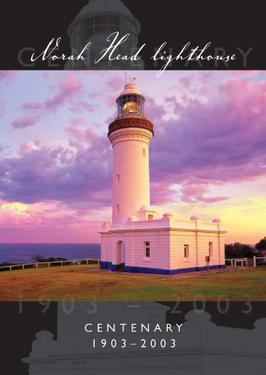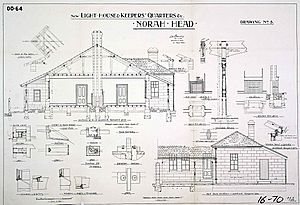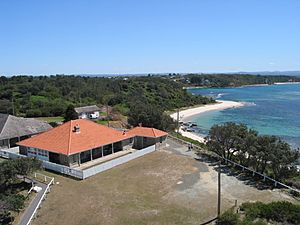Norah Head Light facts for kids
| Tower shape | cylindrical tower attached to 1-story keeper's house |
|---|---|
| Original lens | 1st order bivalve Chance Bros. dioptric Fresnel lens |
The Norah Head Light is a famous lighthouse located at Norah Head on the Central Coast, New South Wales, Australia. It's near the town of Toukley. This lighthouse is special because it was the last one built in a particular style by James Barnet's team. It was also the last lighthouse in New South Wales to have people living and working there to keep the light shining.
The lighthouse first lit up in 1903. Over the years, its light source was updated several times. It started with a kerosene lamp, then became electric in 1961. In 1994, it became fully automatic, meaning people no longer needed to live there to operate it. The lighthouse celebrated its 100th birthday in 2003.
The tower is made of concrete blocks and stands about 27.5 meters (90 feet) tall. At the very top, there's a gallery made of bluestone. The original lantern, made by Chance Bros., still sits on top of the gallery. Other important buildings at the site include the main lightkeeper's house and a duplex for assistant keepers, plus a flag house.
Contents
History of the Lighthouse
Why Norah Head Needed a Lighthouse
People started asking for a lighthouse at Norah Head way back in 1861. This area was known for many shipwrecks, making it dangerous for ships. A local landowner, Edward Hargraves, was a big supporter of building a lighthouse here in the late 1800s. Finally, in 1897, the Newcastle Marine Board officially suggested building it.
Building the Lighthouse
The lighthouse was designed by Charles Assinder Harding. He also designed other famous lighthouses like Cape Byron Light. Construction began in 1901. Workers used a method called "day labour," meaning they were paid daily. Materials were brought by boat and unloaded at a special wharf built just for the lighthouse. The light officially shone for the first time on November 15, 1903.
The tower and houses cost about £24,000 back then. The tower itself was about £19,000, and the special light equipment cost £5,000.
How the Light Worked
The first light source used vaporized kerosene. It was very bright, shining with an intensity of 438,000 candles. Ships could see it from about 18 nautical miles (33 kilometers) away.
The original light mechanism was like a giant grandfather clock. Heavy weights slowly moved down a 30-meter (100-foot) central column as the light turned. Keepers had to wind these weights every half hour! The light spun very fast, completing a full turn every 10 seconds. To make it spin smoothly, it floated in a bath of over 15,000 pounds (6,800 kg) of liquid mercury.
Upgrades Over the Years
- In 1923, the light source was upgraded to a more powerful kerosene burner.
- In 1928, the light was changed to revolve every 30 seconds. This made it easier for the keepers to operate.
- In 1961, the light became electric. It was much brighter, shining with 1,000,000 candles. An electric motor replaced the old weight system. At this time, the number of lightkeepers was reduced.
- In 1994, the lighthouse became fully automated. This meant people no longer needed to live there to operate it. Norah Head Light was one of the last lighthouses in Australia to become automated.
Today, the light uses a powerful 1000-watt lamp. It flashes white every 15 seconds and can be seen from about 26 nautical miles (48 kilometers) away. It also shows fixed red and green lights for ships sailing along the coast.
What You'll See at the Lighthouse
The Lighthouse Tower
The lighthouse tower is 27.5 meters (90 feet) tall. It's built from concrete blocks that were made right on the spot using local materials. These blocks were then lifted into place and covered with a smooth cement finish, painted white. This building method helped save money back then.
Inside the tower, there are 96 steps leading up to the top gallery. The stairs are made of concrete with slate steps and a fancy iron and brass railing.
At the very top of the tower, there's a bluestone gallery and balcony with metal railings. The lantern room sits on top of this gallery. It's made of metal and glass, protected by clear panels. A decorative iron walkway goes around the glass, allowing for cleaning. This lantern house is the original one from 1903, made by Chance Bros.
Inside the Tower Entrance
The main entrance door is made of cedar wood. It has glass panels with a special etching that says Olim Periculum Nunc Salus. This is Latin for "Once Perilous, Now Safe." Above the door, you'll see "•A1903D•", which shows the year the lighthouse officially opened.
On the first floor, there's an entry hallway with original tiled floors. One room was used for administrative work and keeping records. Today, it's a radio room. The second room now holds the electrical controls for the light, including sensors that turn it on. It also has backup batteries, a diesel generator, and a small workshop.
Keeper's Cottages and Other Buildings
The lighthouse complex includes a lightkeeper's cottage and a duplex for assistant keepers. These homes are also made from unpainted concrete blocks. The main keeper's cottage has a verandah on three sides.
Other buildings include small fuel stores, a workshop, and a paint store. There's also a flag house, which was built to match the lighthouse. It used to hold a timber flagpole for sending signals to ships. Today, it stores maritime signal flags.
A stable was also built at the site. In 1960, it was turned into a garage. You can still see the original timber doors from the stable. The complex also has underground fresh water tanks.
About 100 meters (330 feet) up the hill, there used to be a weather station. It collected weather reports and sent them to Sydney. Now, this is all done electronically.
Visiting Norah Head Light
The lighthouse is located on a narrow strip of land between the ocean and Tuggerah Lake. It's easy to get to, and you can take guided tours every day of the year. The only exceptions are Anzac Day and Christmas Day.
You can even stay overnight in two of the cottages! Each cottage can sleep up to eight people. The lighthouse is also a popular place for weddings.
See also






